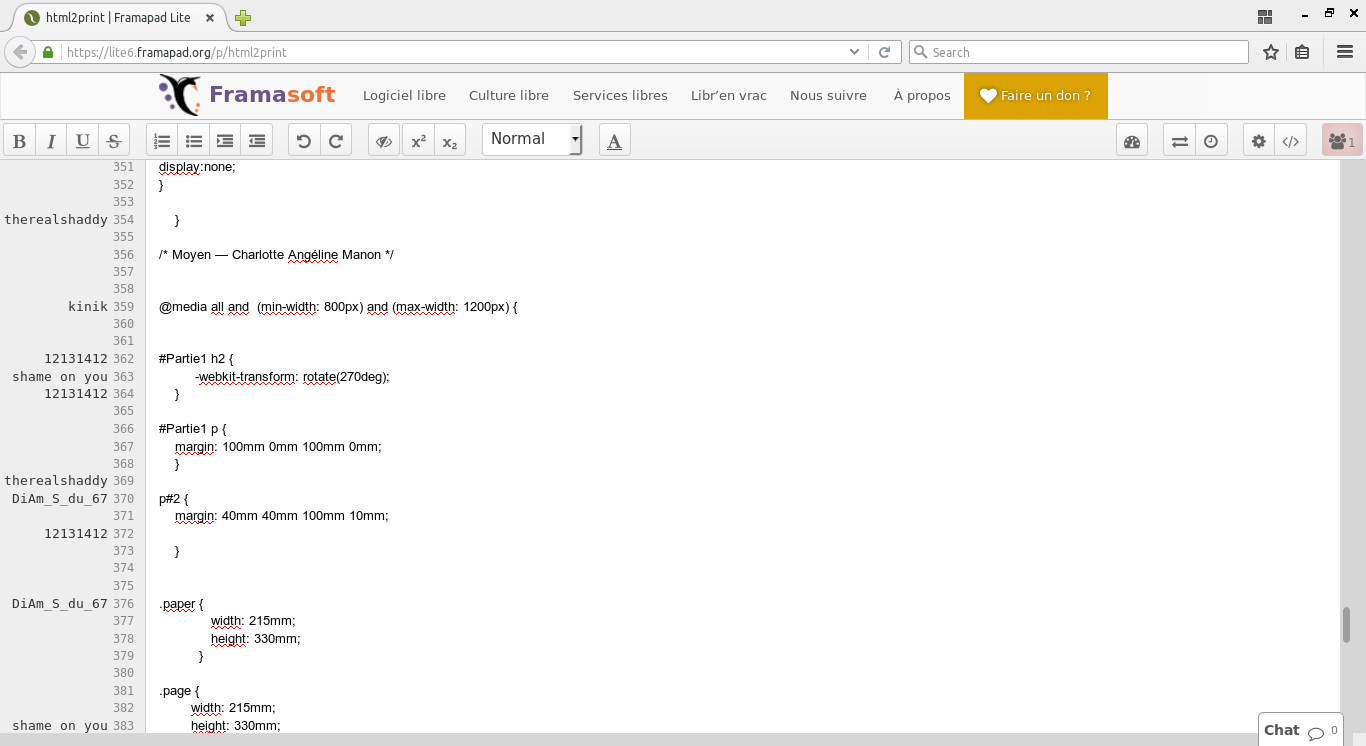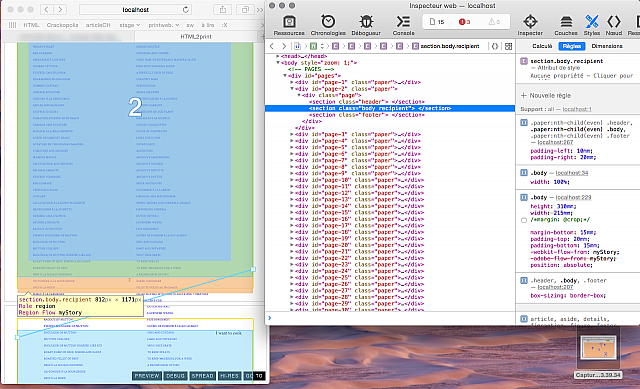HTML sauce cocktail, sauce à part
PREFACE
Ce texte a été initialement écrit pour la revue Back Office. Pour des raisons de format, il n’y sera pas publié, mais nous sommes heureux de le partager ici avec vous dans sa version longue.
HTML2PRINT SANS SAUCE
Depuis sa création en 2006, Open Source Publishing dessine des mises en page et code avec des logiciels libres ou open source. Il s’agit d’abord de questionner nos pratiques avec ces médiateurs omniprésents que sont les outils numériques et les communautés dont ils sont issus. Alors que la matérialité de l’informatique s’efface derrière des interfaces «intuitives»2, le logiciel libre, par sa nature ouverte, invite à saisir l’épaisseur culturelle des formats, interfaces et usages.
Splines spirographiques, filtres ImageMagick ou lignes de commande sont quelques-unes des rencontres qui ont changé notre manière d’appréhender le vecteur, le bitmap ainsi que la manière de construire et de partager nos propres outils. Mais pour ce qui est de la mise en page, nous nous retrouvons face à un dilemme cornélien: celui d’avoir à choisir entre d’un côté une approche essentiellement visuelle, incarnée par Scribus et InDesign, et de l’autre une approche intégralement programmatique incarnée par TeX, LaTeX ou Context.
Dans sa tentative de simuler la manipulation directe de l’objet final, l’approche WYSIWYG se heurte aux limites du paradigme papier/ciseaux. Prisonnière de l’héritage de Gutenberg, elle ignore le potentiel de réinvention du média numérique. L’approche programmatique s’avère elle aussi décevante car systématique et linéaire. Fonctionnant à sens unique, du code vers le visuel, elle fonctionne bien pour mettre en page des flux continus mais permet très difficilement de débrayer et de créer des mises en pages plus articulées, notamment car le format final n’est plus éditable.
Après nous être au départ plus particulièrement concentrés sur des objets imprimés, nous avons commencé à investir le web comme espace de publication. Ce qui nous séduit dans le design web est l’approche collaborative ainsi que le va et vient qu’il permet entre design visuel et design par le code. Populaires, ultra-documentés et basés sur des formats ouverts élaborés par différents acteurs dans un souci de dialogue 3 et de continuité, les langages du web sont de véritables lingua franca: ils sont éditables par de nombreuses manières, «à la main» et via un large spectre de logiciels visuels ou programmatiques. Le navigateur web, pièce maîtresse, réunit en un même espace ces différentes approches. Par sa nature distribuée (une page étant généralement le résultat de l’agrégation de nombreuses ressources telles des feuilles de style ou des images), les formats du web permettent un travail collaboratif entre des personnes aux compétences diverses, contrastant avec l’approche solitaire des logiciels comme InDesign ou Scribus.
À divers niveaux tous les membres d’OSP ont une pratique du web et cette question revient : «Ne pourrions-nous pas utiliser les mêmes méthodologies et outils pour le design imprimé?». Après un petit audit nous décidons de nous lancer. Le premier projet sera pour le programme annuel du Théâtre la Balsamine. Mais si un grand nombre de propositions pour l’imprimé sont déjà prévues par les standards CSS, de nombreuses fonctionnalités indispensables (traits de coupe, pagination, titres courants…) ne sont pas encore implémentées dans les navigateurs web. Pour palier à ces lacunes, nous compilons une série de recettes pouvant désormais servir de gabarits pour de futurs projets. Nous l’intitulons html2print.

SAUCE COCKTAIL
Mars 2015, après deux années de pratique d’html2print en interne pour diverses commandes graphiques, nous pensons que l’outil est prêt à être «bêta-testé» par d’autres, notamment par des designers qui ne sont pas nécessairement développeurs. L’occasion d’un workshop à la HEAR de Strasbourg tombe à pic: quatre journées pour apprendre les bases HTML + CSS et produire un objet imprimé.
Par ses contraintes de tailles d’écrans multiple devices, la mise en page web se doit d’être adaptative, quelque part consciente de l’environnement dans lequel elle s’installe. De ce point de vue, elle s’oppose au design imprimé où la plupart des interfaces traditionnelles gardent nos mains fixées sur les blocs de Gutenberg. Nous proposons aux étudiants d’expérimenter les media queries, conditions CSS qui adaptent le design d’un site en fonction du dispositif de lecture (ordinateur, tablette, GSM…) ou de la taille de l’écran du lecteur. La fluidité du HTML rend très facile le changement de format: un changement dans les dimensions de la page et le reste coule. Pour épicer la sauce, nous proposons aux étudiants de travailler sur un Etherpad 4 permettant de produire ces différents formats à partir d’un même document. La taille de la fenêtre du navigateur change le format de la page imprimée ainsi que son design. Et, le fait de partager un seul et même document rend l’apprentissage de HTML et CSS beaucoup plus excitant et rapide. Les étudiants apprennent par eux-mêmes en voyant les changements des autres en direct.



Photo © Hugo Serraz, licence Art Libre
Pour profiter pleinement de l’outil, nous proposons de travailler à partir d’un contenu d’une certaine longueur, avec plusieurs niveaux d’informations. Nous glanons sur le projet Gutenberg5 The Belgian Cook Book de Mrs. Brian Luck, une compilation de recettes d’émigrés belges au Royaume-Uni en 1915. L’avantage de cette archive étant que les livres y sont proposés dans différents formats dont HTML.
La première journée est consacrée à un cours accéléré sur les expressions rationelles (grep)6 et syntaxe de base des langages HTML/CSS. Le jour suivant, des groupes ad hoc et perméables se forment autour de plusieurs chantiers: nettoyage et optimisation des contenus en utilisant des expressions rationnelles; structuration sémantique des contenus HTML (titres, sous-titres, termes techniques, listes, etc.) et enfin la définition des styles visuels communs à tous les formats imprimables.
Puis, cinq équipes sont formées, chacune prenant en charge un format d’impression: A7 ? micro-format travaillant sur une mise en page en miroir; A6 paysage ? fiches de cuisine cannibale où les ingrédients sont remplacés par des noms de personnes avec grep; 215×330mm ? grand format à consulter posé sur une table; 990×1075mm ? affiches sérigraphiées avec zoom sur les adverbes avec grep; multi-format ? grâce à la propriété float de CSS, les blocs de recettes coulent de gauche à droite comme du texte, la mise en page s’adapte ainsi d’elle-même selon la taille du livre. Une sixième équipe se consacre à la réalisation d’illustrations ASCII via Etherpad.

Nous travaillons sur Etherpad4, un éditeur de texte collaboratif. C’est un des points clés du workshop: la mise en commun du code rend son apprentissage beaucoup plus excitant et rapide. Les étudiants apprennent les uns des autres en voyant les changements en direct. Un seul document définit l’ensemble des objets à produire: la taille de la fenêtre du navigateur change le format de la page imprimée ainsi que son design, suivant les règles de tailles, définies en CSS.

Le dernier jour du workshop est consacré à l’impression, à la prise de vue8 et présentation des objets éditoriaux. Les fichiers sources et l’historique du projet sont mises en ligne sur GitHub. 9.

Photo © Hugo Serraz, licence Art Libre
DEGUSTATION
Concevoir un objet imprimé avec HTML est une expérience nouvelle pour tous et la différence de niveaux des étudiants (degré d’étude, connaissances techniques) ne s’est pas manifestée. Html2print est un outil pédagogiquement intéressant car il supprime le clivage écran/imprimé. De plus, les navigateurs web étant par conception tolérants à l’erreur, ils permettent toujours d’obtenir un résultat, même imparfait. Par ailleurs, le fait d’avoir plusieurs objets sur un même document était très stimulant pour les étudiants qui pouvaient à tout moment suivre leur évolution. Au-delà leur intérêt ortho-typographique, les expressions rationnelles furent grandement utilisées pour tordre les contenus et leur design. Enfin, le fait que les technologies abordées dans le workshop soient très populaires et documentées sur le web, en anglais mais aussi en français, aiguise la motivation des étudiants.
SAUCE SAMOURAI
Suite au workshop donné à la HEAR Strasbourg, la sauce html2print commence doucement à prendre et continue de s’imprimer sur papier. Ainsi deux participants au workshop ont poursuivi leur travaux: Hugo Serraz et Léna Robin.

Photo © Hugo Serraz

Photo © Léna Robin
LIENS
- Fichiers source d’html2print: http://osp.kitchen/tools/html2print/
- Article de blog des étudiants de la HEAR: http://comgraph.hear.fr/2015/03/html-sauce-cocktail/
- Fichiers source du workshop: https://github.com/HEAR/HTML_sauce-cocktail-workshop-OSP
- Site répertoriant des mises en page générées par du code: http://computedlayout.tumblr.com/
NOTES
- Nous avons nommé notre workshop «HTML sauce cocktail» en référence au contenu apporté pour le workshop, un livre de recettes de cuisine belges, et aux sauces typiques des fritkots du royaume. ?
- Qui ne demande pas à penser, basé sur des reflexes, des habitudes, des gestes familier. ?
- Cela ne signifie pas qu’il n’y ait pas des jeux de pouvoir dans la définition de ces formats. ?
- Etherpad est un éditeur de texte collaboratif et synchrone: les utilisateurs peuvent écrire en même temps sur un même doculent http://etherpad.org/. Dû aux restrictions de sécurité web des institutions publiques, nous ne pouvons pas utiliser le serveur Etherpad personnel d’OSP. Nous avons dû aller sur Framapad http://framapad.org/ pour contourner ce problème. ?
- Le projet Gutenberg est une archive de livres du domaine public: des livres que l’on peut redistribuer et réutiliser librement parce que les droits d’auteur ont expiré 70 ans après la mort de celui-ci. http://gutenberg.org/ ?
- Ensemble de fonctions permettant d’automatiser la recherche et le remplacement d’éléments définis au préalable dans un texte. Une fonctionnalité que l’on retrouve dans divers langages de programmation, d’éditeurs de code et même dans… InDesign. ?
- Intervenants : Stéphanie Vilayphiou, Colm O’Neill et Ludi Loiseau. Avec les étudiants en communication graphique années 2 à 5 : So-Hyun Bae, Laura Burucoa, Charlotte Chowdurry, Victor Donati, Montasser Drissi, Angéline Girard, Romain Goetz, Manon Hachad, Quentin Juhel, Théophile Martin, Arman Mohtadji, Clara Neumann, Lisa Pagès, Benjamin Riollet, Lena Robin, Hugo Serraz, Caroline Sorin. ?
- Consultable sur le blog des étudiants de la HEAR : http://comgraph.hear.fr/2015/03/html-sauce-cocktail. ?
- https://github.com/HEAR/HTML_sauce-cocktail-workshop-OSP. ?












